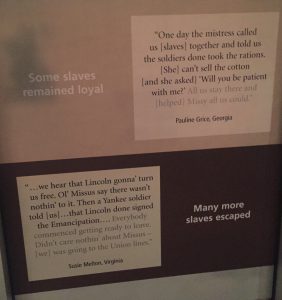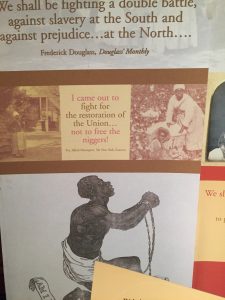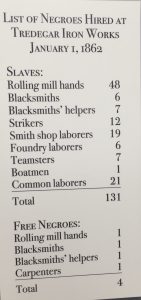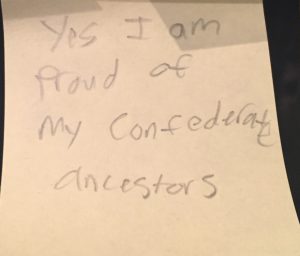By Maryam Tahseen
For my site visit as a summer researcher, I decided to visit the American Civil War Museum at Tredegar. Even though the Civil War was fought between 1861 and 1865, the museum’s timeline started from 1775 to demonstrate the build-up to the war. The war was fought between the Union in the North and the Confederacy in the South. According to the museum exhibit, many economic and political reasons were given for the war; however, the main issue underlying all these reasons was slavery. The Confederates advocated for each state’s right to perpetual slavery and its expansion into other states while the Unionists swore their allegiance to the United States constitution and eventually fought for the freedom of slaves.
The exhibit was organized chronologically. It had uniforms and pictures of some of the soldiers who fought in the war, the first Confederate flag, posters that were used to inform black people of slave hunters, weapons and medical kits used in the war, and much more. The museum attempted to present the war from multiple perspectives. One could hear the narrative of the South and the North, read stories of the enslaved black people who fled to the North for their freedom and those who remained loyal to their masters, read quotes from the white soldiers of the North who fought for the freedom of the black people and those who contested their freedom.
Furthermore, the museum not only depicted black people as enslaved individuals who needed to be rescued by the “whites”, but also as dignified and independent individuals who participated in the war for their freedom and organized rebellions. One such example was a diorama in the museum of Colonel Tye, an escaped enslaved individual, who organized a rebellion for freedom of the people of his race. He was depicted as a valiant and feared warrior, which was unlike the ubiquitous narrative of black people only as a helpless populace. The museum also told the story of the enslaved black community in Haiti who revolted against their French masters and were able to establish the independent Republic of Haiti. These incidents depicted the role of black people as more than a community that needed to be rescued by the “whites”.
One the other hand, I felt as if the museum implicitly glorified some of the Confederate generals such as Robert E. Lee. There was one story where Lee was offered the command of Union forces by Abraham Lincoln but he refused by saying that he “could not raise hand” against his birthplace. Such quotes by Confederate generals show them as very patriotic when in reality they believed that black people were three-fifths of a human and fought to keep them enslaved. Another incident of implicit racism that I found at the museum was a diorama of canon-making at the Tredegar foundry. Just before the diorama, there was this prolonged description of the black people who worked at the foundry either as enslaved people or as free people. However, when I looked at the figures portrayed in the diorama, none of them was black.
Overall, visiting the Civil War museum was a great learning experience for me and I had a great time until I saw the opinions section at the end of the museum. The opinions section asked how the museum made the attendees feel. On one of the post-its by an attendee, it said: “I am proud of my Confederate ancestors.”
Maryam Tahseen is a rising Junior majoring in Accounting with a concentration in Finance and minoring in Women, Gender, and Sexuality Studies. She is from Islamabad, Pakistan. As an international student, she is very excited to uncover the lives of international students along with underrepresented minorities through this project.




